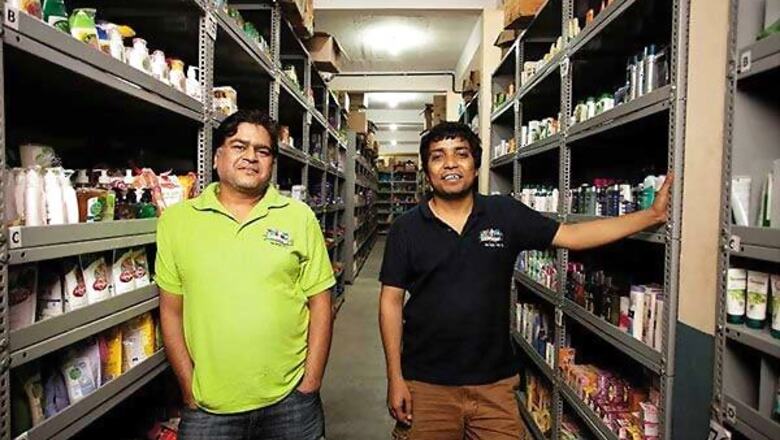
views
"Don't forget to get me a 2-kilo pack of Baba Ramdev's detergent powder," said the voice on the other end of the phone to Bal Krishn Birla.
Birla, as he is known to most people in Bangalore's closely-knit startup ecosystem, is a jovial 40-year-old who defies classification by virtue of being an IIT graduate, former CTO at online classifieds company Asklaila, one-time restaurant owner, brainchild behind a 20,000-member-strong global community of old Hindi music aficionados and the source of an unending supply of 'PJs' of dubious antecedents.
The person Birla was talking to was a former colleague and friend who he was going to meet. The detergent wasn't to be picked up at Patanjali Yogpeeth in Haridwar, where Ramdev's business empire is headquartered, but from a 2,500-sq ft warehouse in Kudlu, Bangalore.
The warehouse belongs to Zopnow.com, a two-year-old Bangalore startup operating in that infernal hell of ecommerce: Groceries.
Birla is co-founder and CEO. "We stock over 100 SKUs (stock-keeping units) of Baba Ramdev's products and he is one our fastest-selling brands," he says. From soaps to spices to flour to cosmetics, these products are apparently giving competitors from the likes of Hindustan Unilever, Nestle or ITC a run for their money.
Ironically, and somewhat serendipitously, Zopnow ended up unearthing a huge market for products sold under a yoga guru's name in what is arguably India's most modern retail market.
"Because they are not available everywhere, Baba Ramdev's (products) are what I would call 'low-distribution' products. So the store loyalty you can get by satisfying a fan of Baba Ramdev's Amla Candy, you'll never get by selling someone Maggi," says Damodar Mall, the head of customer strategy for Reliance Retail's value business.
No Country for Slow Men
The grocery space has long held a mythical status among ecommerce entrepreneurs because of its sheer size and repeatability. Every household needs groceries. And very few derive enjoyment from buying them.
It's a category that is ideal to be "disrupted" by the internet.
Except that doing so is damn near impossible. Very few companies have managed to crack the economics of this low-margin space anywhere in the world. Everyone knows of Webvan, one of the 'stars' of the dotcom implosion, by virtue of going belly up after spending and raising over a billion dollars by 2001. Even Amazon, a company possessed of almost boundless ambition and capital, spent nearly five years delivering groceries in just a few Seattle neighbourhoods before expanding into a couple of more US cities earlier this year.
In India, the last three years have seen a mushrooming of grocery ecommerce sites in many metros. Everyone is blinded by the size of the overall market: $35-40 billion worth of FMCGs across the country, of which modern retail accounts for around 5 percent. "In cities like Mumbai, almost 40 percent of grocery orders already happen over phone, so the customer is ready for non-store offerings, including the internet," says Mall.
Though none of the players gives out revenue numbers, research indicates that the largest player in the space is BigBasket with an estimated revenue of $4 million, followed by Zopnow, which is around $2 million in revenue, and MyGrahak.
By and large, the majority of players restrict themselves to pre-packaged food and consumer goods, staying clear of easily perishable produce like vegetables, fruits or meats. Those that do deliver fresh vegetables, like BigBasket or Town Essentials, have a much more complex supply chain.
Yet, selling groceries online is quite unlike most other forms of ecommerce. For one, you cannot create economies of scale across the country. Grocery retailing makes sense only at a "hyperlocal" level, because products need to be stored and shipped at as minimal a distance from the customer as possible. Even the assortment of products is specific to local tastes and preferences: What sells in Bangalore may not in Gurgaon or Pune.
"In grocery retail, there is little advantage gained from a national presence because the supply chain and assortment in each city needs to be localised. So each city ends up being largely like an independent business," says Mall.
Margins are often razor-thin, and deliveries cannot be outsourced to third parties.
"Raising money turned out to be very tough for us. Many VCs told us they'd write us a cheque only if we decided to start any other ecommerce business," says Birla. But he and Mukesh Singh, Zopnow's other co-founder, persisted, drawn towards groceries because it represented a "multi-billion dollar domain" and because they figured that sooner or later Indians were going to want to spend their weekends vacationing or entertaining, instead of worrying about groceries.
And though the results are still tentative and confined to one city, they are promising.
Zopnow's average order size has gone from approximately Rs 700 when it started to around Rs 1,300 today, claims Birla. That's about the same ballpark as most leading ecommerce sites in India.
But the "stickiness" of the grocery category combined with the loyalty of its customers, three out of four of which order regularly from Zopnow, allow it to generate much more revenue from each. "Many of our customers order as often as three times a month from us," he says. That means a revenue of nearly Rs 47,000 per loyal customer annually.
"When we started out, we were told by many people, including venture capitalists, that 6-7 percent was what we could expect in terms of gross margins," says Birla.
While it's true that many staples and foods offer only low single-digit margins, concedes Birla, the objective should always be to sell the customer a more profitable "basket" that combines, say, sugar at 6 percent along with organic staples at 30 percent and steel utensils at 60 percent margin, respectively.
Free from the constraints of in-store display and checkout formats, Zopnow uses custom analytics to get customers to add more products into their virtual baskets.
And as the average number of items in its customers' baskets has gone up from 8-9 when they started out to 20-22 now, Birla claims Zopnow's gross margin has risen to a healthy 15 percent with added scope to rise up to 20 percent over the next year.
That gross margin can easily translate into a net profit margin of 6-7 percent, says Singh, 38.
Most large grocery retailers, including Walmart, operate at nearly half that figure. Mall, a veteran of the modern grocery trade (before Reliance Retail, he worked with the Future Group's Big Bazaar and Food Bazaar, and Hindustan Unilever), says he doubts the ability of any grocery retailer to generate more than 3 percent in terms of net profits.
"An online grocery business needs to track its profitability at four levels -the SKU, the basket, the warehouse and finally, the company," says Birla. He says Zopnow has always been profitable on the first two counts, and is six months away from becoming profitable on its first warehouse.
Birla expects the newer warehouses that he puts up, beginning with one in north Bangalore in a couple of months, to become profitable in 12 months compared to the 24 months it took his first one. The reason, he says, is volumes will pick up much faster because potential customers already know of his brand.
In July last year, Accel, Qualcomm and Times Internet invested $2 million in Zopnow, according to Venture Intelligence, a research service focussed on PE and M&A. Big Basket, its larger competitor that also started from Bangalore and has now expanded to Hyderabad and Mumbai, raised $10 million in venture funding last year.
But the ace up Zopnow's sleeve is the "three-hour delivery" promise -either a stroke of genius or a millstone around their neck.
The three-hour Delivery
Six to 12 hours is the average delivery promise for most of Zopnow's competitors, with a few even taking up to 24 hours. To be able to deliver orders within three hours, Zopnow has solved quite a few supply chain problems.
To begin with, the placement of products in its warehouse has been optimised for the fastest "picking time"-the time taken by one of its staff to assemble all the products ordered by a customer. An in-house designed software (almost all of the IT has been designed in-house-the side-effect of having two CTOs as founders!) automatically generates "picking sheets" which tell an employee the exact sequence and location of products to be collected.
"We take around one minute to pick an SKU currently, compared to two to three minutes when we started out. Our goal is to bring that down to 20-30 seconds soon," says Birla.
If that sounds unimpressive, consider the fact that it currently claims to stock over 10,000 SKUs. "An average kirana store stocks 1,500 SKUs while a Big Bazaar usually has 7,000-8,000 SKUs," he adds by way of comparison.
Post picking, a barcode-based checkout process eliminates any manual errors. The bags filled with products are then assigned to one of the 35 delivery employees, once again based on an algorithm designed in-house, which takes a customer's precise latitudes and longitudes into account. Deliveries to farther suburbs are done through vans that can carry enough orders for two three-hour slots (Zopnow offers four distinct three-hour slots for delivery).
"Unless you have a network of physical stores, doing a three-hour delivery profitably is impossible. Because it means you're shipping every order without getting the time to aggregate. And small orders sent over long distances never work out economically," says Mall.
But Birla claims that thanks to volumes and technology, Zopnow today "clubs" nearly three times as many orders per delivery route than when it started. As a result the average distance travelled per order has fallen nearly 60 percent during the same period.
To even out the orders across slots, Zopnow claims it's had good success through the use of proprietary reward points called "Zoppies". Many customers are okay trading their delivery slots in lieu of extra points, says Birla. And once the order is on its way, a customer can track the location of Zopnow's delivery staff live on her browser or mobile app.
Meanwhile, back at the warehouse, another software automatically sends out replenishment orders to manufacturers or distributors based on depleting inventory due to order fulfilment. Birla claims a three-hour delivery window helps Zopnow turn over its inventory much faster than competitors. "We currently turn over our inventory in 21 days, but want to improve that to 15 days. Our suppliers give us two to three weeks of credit in turn," he says.
Added with the fact that customers pay cash the same day, Zopnow is close to achieving a zero cash flow status on inventory, thus freeing up its cash for more productive uses.
"After covering all of Bangalore, our next focus will be on Pune and Gurgaon-two cities with high internet penetration, highrises and people working in the IT sector. Over the next two years we want to be in five cities, going up to 20 cities in the long run," says Birla.
Big dreams, those. But what the world will be watching is something else: How the business model for online groceries gets established. There is more at stake in Zopnow than merely its business success.




















Comments
0 comment